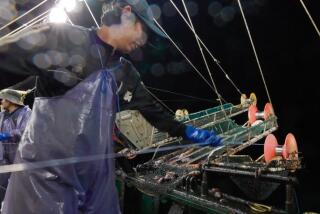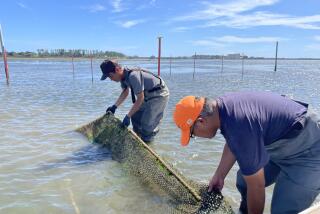Huge Potential in Sea Farming Reported
- Share via
WASHINGTON — Scientists at the Smithsonian Institution have reported, after two years of research, that sea farming in tropical waters has enormous potential for producing inexpensive, plentiful supplies of fish for a hungry world.
Dr. Walter H. Adey, director of the Smithsonian’s marine systems laboratory at the National Museum of Natural History here, described the prospect of “mass world fisheries” producing fish at 10 cents to 30 cents a pound with simple equipment that fishermen in underdeveloped countries can easily be trained to use.
Adey said at a news conference that he and a team of scientists had found evidence contradicting a long-held belief that the open seas were low-nutrient deserts inhospitable to plant life.
Effort Started in 1983
The research effort began in January, 1983, off Mayaguana Island in the Bahamas and continued off Grand Turk in the Turks and Caicos Islands in the Caribbean Sea last year, he said.
Adey said the Bahamian coral reefs studied by his team of scientists yielded rapidly growing algal turf--an underwater lawn of seaweed--on which a wide variety of sea animals grazed.
The key, he said, was the back-and-forth motion of waves and currents that continually fed this turf with nitrogen, phosphorous and other nutrients washed in from the equatorial ocean. The constant waving of the underwater plants limits their exposure to harmful ultraviolet rays from the sun and accelerates photosynthesis, he said.
As a result, Adey said, abundant supplies of algae are produced in these tropical waters. Production is five to 10 times greater than most high-quality farming operations on land, he said.
High-Protein Animals
Instead of turning the algae into a food additive that humans might find distasteful, Adey decided to use it as feed for high-protein sea animals that humans could eat.
Adey’s research group chose the Caribbean king crab, a large tropical spider crab, to feast on algae collected artificially on plastic screens submerged one to two feet under the water’s surface and harvested every few days.
With the cooperation of the Agency for International Development, Adey said, “mariculture” fisheries are being developed off the Turks and Caicos Islands, the Dominican Republic and Antigua. Test trials show that the crabs, feasting constantly without fear of sea predators, are maturing to market weight of two to four pounds in just one year, he said.
100 Maricultures
A second mariculture program, based on reef-produced algae, is under way, using a large snail known as welk, topsheel or magpie shell, which is regarded as a delicacy by many inhabitants of the Caribbean. Adey told reporters that 100 or more maricultures can be developed, using sea urchins, fish and other marine life found along the tropical reefs.
Adey predicted that Caribbean king crab could be mass-produced on sea farms and sold for $4 a pound, eventually replacing the $500-million Alaskan king crab market, which collapsed when that species was depleted.
He said that about 3,000 fishermen could be employed immediately to sea-farm the Caribbean king crab, yielding initial earnings of about $50 million on a minimum investment of about $5,000 per fishermen, and about double those earnings for related industries.
More to Read
Sign up for Essential California
The most important California stories and recommendations in your inbox every morning.
You may occasionally receive promotional content from the Los Angeles Times.










